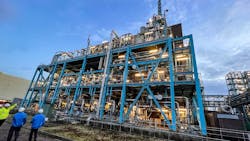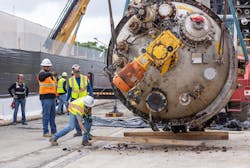3 Key Takeaways
- Geographic shifts are reshaping the second-hand equipment market as manufacturers return production to home markets in the United States and Europe, driven by logistics and supply security concerns.
- Time and cost savings are substantial motivators — with potential savings of up to 70% on whole plants and equipment delivery times reduced by up to 90% compared to buying new.
- Success with second-hand equipment requires a pragmatic approach: Buyers should focus on getting plants operational before making major modifications and be prepared to accept an 80% technical fit in exchange for faster deployment and lower costs.
While undergoing substantial changes, the market for second-hand process plant and equipment is thriving, although there can be traps for the unwary. On the other hand, the benefits can be substantial.
The biggest change in the second-hand plant business is a geographical shift in the marketplace. Companies from the United States and Europe that moved production around the world are coming back to their home markets for logistics and supply security reasons, according to Ross Gale, vice president, director of acquisitions and consultancy at International Process Plants (IPP).
“There are always areas of growth and contraction/restructuring,” says Gale, whose company sells new and used process plants, systems and equipment. He notes that having centers of operational excellence in the United States, the U.K. and Germany somewhat insulates the company.
For example, the company’s German operations currently is busy selling off ammonia, methanol and melamine plants from BASF's Ludwigshafen Verbund site. A victim of energy market changes in Europe, Gale anticipates the plants moving to countries with a better energy supply situation than Germany.
In the U.K., the company has acquired a chemical and API manufacturing facility in Grimsby. Formerly owned by Novartis, the 170-acre integrated facility includes three manufacturing buildings with dedicated lab facilities and over 1,000m3 of reaction capacity. It has high-volume, multi-purpose, multi-product capabilities with chemical syntheses, including hydrogenation, Grignard/Friedel-Crafts reactions, azides and tin chemistry.
This all fits with IPP’s strategy of buying from major multinationals and selling to small and medium-sized enterprises (SMEs), typically ones with an entrepreneurial spirit.
“Those companies have the forward vision and flexibility needed to see that the perceived risk of used assets is outweighed by the benefit of shorter return on investment,” explains Gale. “This is how you achieve more for less in a significant way.”
High Demand, Fast Turnaround Times
The driver is usually lead-time savings; customers can save up to 50% on “as new” equipment and up to 70% on a whole plant in terms of equipment. Delivery time is cut by as much as 90% with rotating equipment, which typically can have a lead time of over two years if ordered new (Figure 1).
Like many second-hand equipment vendors, IPP’s first point of contact with potential customers is its website. A crucial business tool, this recently has been relaunched to take advantage of AI tools, large language models and over 46 years of equipment and plant data to guide potential customers to what they are looking for as quickly as possible. This is swiftly followed by virtual or in-person inspections, although smaller components, such as valves and instruments, can be ordered directly from the website to save additional time and money.
A typical response time to a query is 48 hours and a material percentage of sales, especially equipment sales, goes to customers with very important needs. For example, a reactor where the glass lining has failed could be on a high-value product campaign earning hundreds of thousands of dollars a day in revenue, especially in the pharmaceuticals space. “Our responsiveness is critical in those cases,” notes Gale.
Second-Hand Quality: What to Expect
How an individual query is dealt with varies from product line to product line. For example, IPP’s sister company Universal Glasteel Equipment focuses on re-glassing. Here, a customer gets a virtually new vessel or vessel part, 30%-35% less expensive than new, with immediate availability. Trades are available for old or damaged glass vessels, too.
Another sister company, Gale Process Solutions, builds process equipment, such as reactors, heat exchangers, filters, dryers, centrifuges, evaporators and columns, both for IPP stock and on a custom-order basis.
The equipment built for stock is fairly generic and designed to capture a wide variety of process conditions so they can be applied to different industries. One example is a 316L stainless steel reactor available with up to 22,000 L (6,000 gal.) capacity. Designed for working pressures of 10 barg (150 psig) and half-pipe jackets, with a sanitary cGMP design, it can be used in manufacturing processes ranging from pharmaceuticals to polymers.
“The idea is to offer top-end equipment, with features such as internal and external polishing that an industrial chemical manufacturer wouldn't need but at a price that is highly competitive with the standard of equipment they would normally order,” explains Gale.
All second-hand equipment comes either “as is” without certification, or with a warranty in the case of rebuild or re-glassing.
IPP also takes on remediation if needed and has 18 such sites currently in its portfolio.
The second-hand business has always been sustainable, too, with 97% of everything the company touches being upcycled. The rest, typically equipment in very poor condition or out of vogue, is scrapped.
Here, Gale cites a study by carbon management specialist Coolset, which estimated that about 4.43 t CO2/t of equipment is saved when buying used equipment compared with new.
Potential Drawbacks to Second-Hand Plants
Going down the second-hand route is not without its pitfalls. For one, engineers typically want a complete solution for the problem they’re trying to solve.
“Such a result rarely can be achieved with second-hand kit, unless you are extremely lucky because it was designed for another process,” Gale says. “But with savings on time and capital you can justify buying something second-hand that is an 80% technical fit.”
When relocating a used plant, there are common pitfalls, too.
“We have a very short and simple best-practice guide to help,” Gale explains. “The goal always is getting your plant into safe operation. Don’t start reinventing the wheel and don’t start making process changes to increase throughput until the first turnaround unless those changes are very straightforward. If you know a particular bottleneck occurs because a heat exchanger is 35% undersized, and that sizing the second-hand one correctly is going to increase throughput by 'X,' then that’s the kind of change that should be made. But you always must focus on getting the plant in operation.”
When acquiring a secondhand plant, the actual risks are often lower than people assume, Gale says. The advantage lies in having access to the facility's operational history, understanding its bottlenecks, and knowing which components need refurbishment before installation.
“Focus on just those things and get the plant running” Gale says.
Value in Specialties and Pharma
Geographical changes are influencing the activities of Foeth, a dealer of used process equipment for the specialty chemical, food and pharmaceutical industries in Europe.
“What’s interesting about this particular equipment is that it represents more value per item, and from 2022-2023 we have doubled our pharma equipment sales in both Central and Southern Europe,” says Stefan Modderman, the company’s chief customer officer.
This coincides with many specialty chemical and pharma companies returning production to Europe from Asia after the COVID-19 pandemic. Now, however, they tend to outsource production to contract manufacturing organizations (CMOs) in countries at the edge of Europe, such as Poland and Spain.
So much so that the company, based in Barneveld, The Netherlands, is planning to open a new stockyard in Spain next year, both to make a bridge to markets in North Africa and to act as a hub with South America via existing shipping routes.
“We sell a lot of equipment to these CMOs,” explains Modderman. “They are interesting for us because they are typically privately owned, with 100-200 employees and an owner or director who can call the shots. These people tend to be entrepreneurs who are willing to take a risk by investing second-hand equipment, even if it doesn’t come with a warranty. That’s a big change.”
Price and availability are the main drivers for customers. CMOs, for example, will typically pick the supplier who can deliver next-day replacements, he says.
The company has developed a cadre of long-term users who have a lot of experience with used equipment. “They understand what second-hand or used equipment actually means,” he noted.
Global Second-Hand Equipment Market Growth
Foeth has made several acquisitions recently, including a powder and liquid detergent manufacturing plant located in Romania. The plant became available after a reorganization of production capacity and included over 1,000 machines and other assets including mixers, powder and filling lines, pelletizers and comprehensive utility systems.
Foeth’s engineers dismantled each piece of equipment before cataloging it and preparing it for pre-sale, Modderman says. After dismantling, the engineers moved every machine to Barneveld or directly to early-bird customers who were looking for fast delivery times.
Foeth is active in India, too, which Modderman notes has now surpassed the U.K. to become the world’s fifth-largest economy and has a pharma market growing at over 12% annually. Heading toward $65 billion a year in value, it is now bigger than Germany’s pharma market, too, he adds.
A recent survey of the company’s Indian API equipment customers found they consider second-hand European equipment to be comparable with, for example, new Chinese equipment on price but with far better quality.
Like IPP, Foeth offers most of the equipment via its website. It, too, has worked to make it as user-friendly as possible so that potential customers can drill right down to the piece of equipment they want — or as close as possible.
“Remember, however, that it’s still very different from buying new, where you know exactly what you need for a certain production capacity,” Modderman advises. “It’s more like buying a used car: you’ll never find exactly the right color or spec that you are looking for.”
Buyer Beware
Foeth sells “as is” but always in working condition. Based on the type of equipment involved the company can provide a mechanical warranty, but only on a case-by-case basis and basically only on reconditioned equipment.
Modderman’s tips for second-hand neophytes: Make sure the seller tests the equipment.
“There are so many parts that could have issues, such as leaking mechanical seals, or a vacuum pump that hasn’t seen service for years,” he says. “Then, be open or creative enough to compare a used item with your existing plant equipment. You probably have the maintenance staff who can deal with minor issues anyway.”
Here, he cites the example of a customer in Oslo who recently bought a large paddle dryer rarely seen on the market. From their testing, Foeth’s engineers knew that the mechanical seal was slightly leaking.
The customer said, “Send it over now. I need to keep the process going and I’ll do some maintenance when the seal arrives,” Modderman relates.
“Even though that would take two months, he was quite happy with this arrangement,” he explains. “This is a completely different mindset to somebody who will wait a year for a new part to be delivered. So, a creative mindset is a big help. The point is to get the process up and running and making money.”
About the Author
Seán Ottewell
Editor-at-Large
Seán Crevan Ottewell is Chemical Processing's Editor-at-Large. Seán earned his bachelor's of science degree in biochemistry at the University of Warwick and his master's in radiation biochemistry at the University of London. He served as Science Officer with the UK Department of Environment’s Chernobyl Monitoring Unit’s Food Science Radiation Unit, London. His editorial background includes assistant editor, news editor and then editor of The Chemical Engineer, the Institution of Chemical Engineers’ twice monthly technical journal. Prior to joining Chemical Processing in 2012 he was editor of European Chemical Engineer, European Process Engineer, International Power Engineer, and European Laboratory Scientist, with Setform Limited, London.
He is based in East Mayo, Republic of Ireland, where he and his wife Suzi (a maths, biology and chemistry teacher) host guests from all over the world at their holiday cottage in East Mayo.


